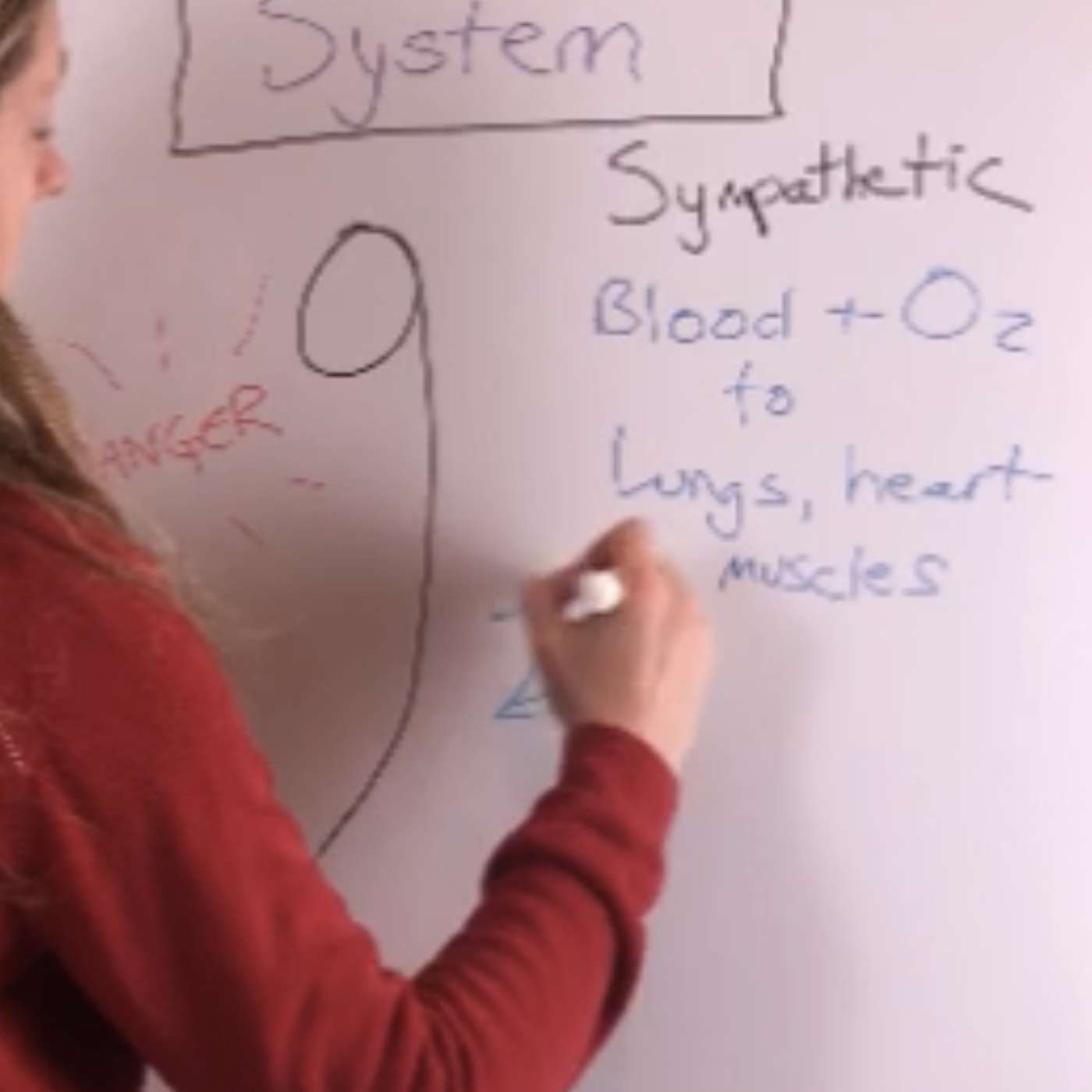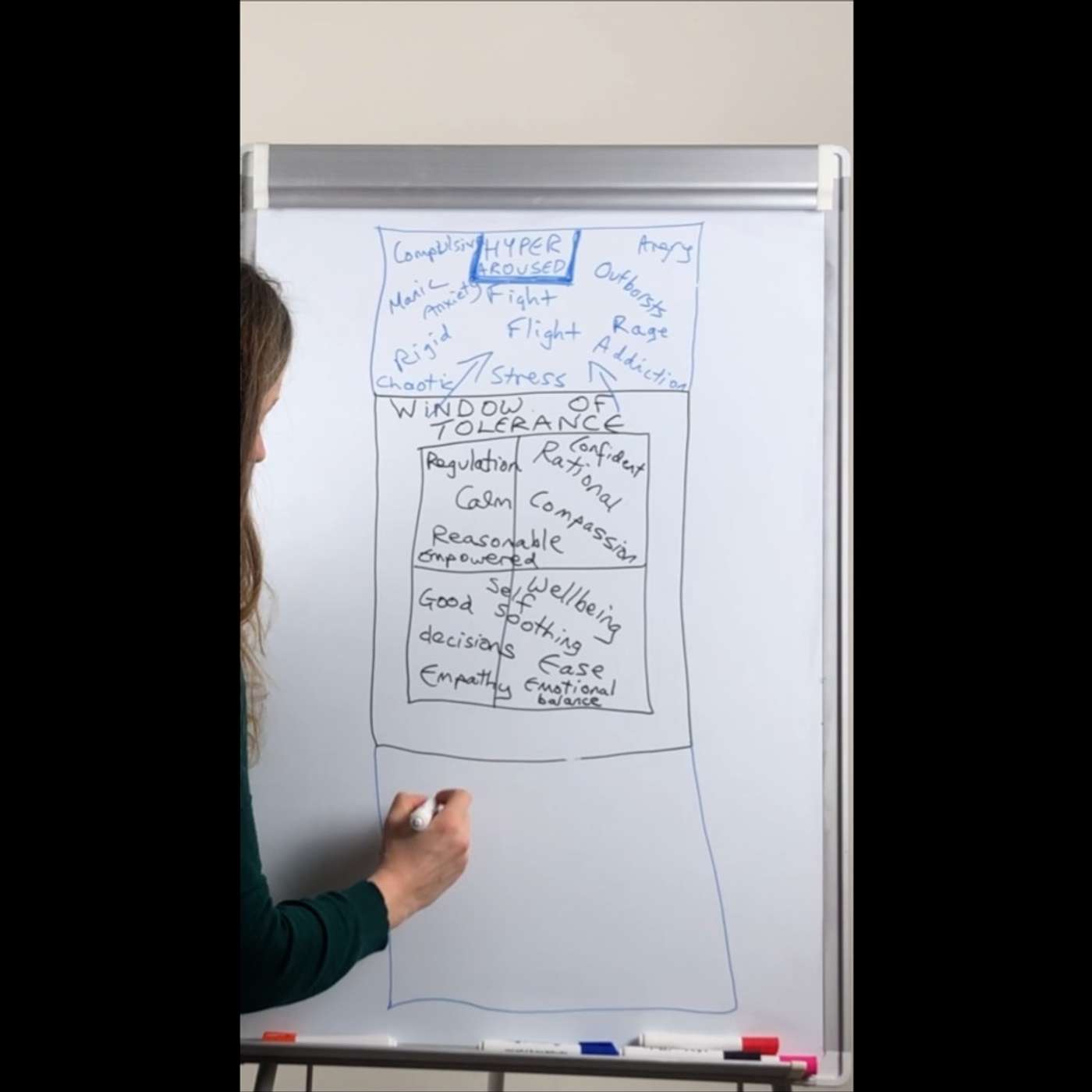.png)
Stress & Anxiety Recovery Podcast
BACP Accredited Body Psychotherapist, Shelley Treacher gives "short, inspirational gems of wisdom" in her Stress and Anxiety-focused podcasts.
Shelley's podcasts are about disrupting harmful patterns, from self-criticism to binge-eating and toxic relationships. Learn how to deal with anxiety, stress, and feeling low, and explore healthier ways to connect.
Stress & Anxiety Recovery Podcast
Reset ANXIETY or DEPRESSION via your Autonomic Nervous System
In this episode, we look at ways to regulate the autonomic nervous system to come out of a stress state, depression, anxiety or compulsion.
I also give you a summary of everything I talked about in the first 8 podcasts of the year. This will give you a massive jump start to coping with anxiety, depression or any compulsion.
We cover:
- The psychology and physiology behind stress, anxiety, depression, binge-eating or addiction.
- Stephen Porges’ ‘Polyvagal Theory' & A ‘Polyvagal’ exercise (to kickstart the parasympathetic response out of anxiety & triggering).
- The physiology of being triggered into stress, anxiety, or depression.
- 11 ways to regulate the parasympathetic nervous system response (to come out of a stress or depressed state).
& More…
Another podcast you will love: EMBODIMENT – The Best Way to Handle Anxiety
Chapters
(0:00:02) - Regulating the Nervous System
(0:09:17) - Self Regulation and Comfort Eating Recovery
Want to see if we're a good fit for working together?
Let's book a complimentary telephone call to talk.
SCHEDULE A COMPLIMENTARY CONSULTATION – with no obligation.
If this podcast helped you, please leave a review on Apple Podcasts
Reset your Autonomic Nervous System (ANS)
I'm going to give you another few ways that you can regulate your nervous system. Hi. I'm Shelley Treacher from Underground Confidence. I'm a somatic psychotherapist, and I help people to recover from comfort eating and feeling anxious.
First, I'm going to talk about the parasympathetic and sympathetic nervous system. I know these are words that you've heard. I thought I'd explain what they mean. Then I'm going to give you another few ways to regulate your nervous system, and then I'm going to give you a summary of everything that I've talked about in the last couple of weeks about regulating. Then I'm going to give you a summary of everything I've talked about in the last few weeks. Here you'll see how it all hangs together and maybe what you need to be working on to recover from comfort eating.
So I was listening to an interview with Stephen Porges this morning And the thing that struck me the most (and perhaps I realize this over and over again in life) is that we are always looking out for some threat.
0:01:03
I don't think the average everyday person realises this.
When we're walking along the street, we're assessing threats and risks. When we're in a relationship, we're assessing whether we're safe, whether there's a threat. When we go to the shops, we're assessing risk. We do it all day long as human beings.
The Autonomic Nervous System (ANS)
Putting it simply, the autonomic nervous system is divided into two parts: The sympathetic nervous system and the parasympathetic nervous system.
The sympathetic nervous system is the one that prepares you for threats or the risk of fight or flight. So here, the body maximises your potential for oxygen and blood flow to your muscles to your lungs and your heart. Just in case you need those to get away or to protect yourself in some way.
Blood flow here is also diverted away from your gut and your digestive system because that's not needed when you're under some kind of threat and you need to get away.
I think this is interesting because often you're in fight or flight when you're comfort eating. So that means the digestive system is not going to be working very well. The parasympathetic nervous system is triggered when the threat is over. When you can return to resting and digesting. This interacts with the sympathetic nervous system and tells it that there is no threat anymore. So this is the part of you that I'm trying to help you activate by telling you all about these self-regulation exercises and ways that you can return to normal.
It's certainly true that when you overcome comfort eating, when you overcome a craving, or when you're feeling just better anyway so you don't need to eat you're in the parasympathetic nervous system. So it makes sense that this is what you might be aiming for.
Laughter resets anxiety
0:02:57
In this next part, I'll talk about a sense of humour and laughing.
Interestingly, laughing kicks up the sympathetic nervous system. So it accelerates your breathing and your heart rate. But then as you start to calm down and stop laughing, your parasympathetic nervous system kicks in. Endorphins kick in as well when you start laughing.
I am going to talk about chemicals in the brain later, but clearly, this makes you feel better. Which tells your system that there's no threat.
Even if you hear laughter, it improves the functioning of your autonomic nervous system. So it will tell your sympathetic nervous system that you can calm down; there's no threat. So that's something you can try.
Listen to laughing and see how it feels.
I think that would be a really funny one to do when you're in a binge craving! Try it. Just try it. Next time you're like, oh, I've got to eat a whole bucket of biscuits. Try listening to laughter. Have something ready for you to listen to. And just see if there are any minute little shifts in how you feel.
(Sounds of laughter)
That was a genuine laugh because I genuinely think all of kind of funny. It wasn't my best laughter, but how did it go for you? I think it's worth trying. I really do.
Singing regulates stress
Humming and singing are another couple of things that act in the same way as laughing. So humming in particular will kick in your parasympathetic nervous system and help you to calm down and feel that there is no danger that you're safe. So would you like to hum with me?
(sounds of humming...)
This is the weirdest, media thing that I've ever done!
(more humming sounds)
Oh, it's satisfying! Just finding your rhythm. Give it a go.
Movement releases depression
0:05:10
Movement, in particular dancing, is also a way to regulate your nervous system. There have been studies to show that dancing can reduce depression. Moving rhythmically, and emotional expression through movements, not only helps you to reduce depression but also improves your brain functioning.
Not to mention the physical benefits. Listening to me on the podcast, you can't see me moving. So I can't demonstrate this one for you. But I will put a link in the show notes. I am going to be dancing on TikTok!
When I first started doing social media on talk. I thought "I am never going to do one of those stupid dancing videos." Here I am!
But as many of you know, I am a dancer. So this isn't entirely new for me, but I'd recommend it. Sometimes it's a lifeline.
Polyvagal Theory
0:06:06
Something else you might have heard a lot about is polyvagal theory. You might have heard that word bandied around, polyvagal. I am not going to scientifically explain that to you. Stephen Porges, the man who I mentioned earlier, who I'd listened to a conversation with this morning, is famous for his polyvagal theory.
The next video you see will be a polyvagal exercise. There is a huge amount of clinical evidence and just evidence with normal human beings that these exercises really help. The idea of them is course is to help you get back into your parasympathetic response, back into rest and digest.
For those listening on podcasts, here's a polyvagal exercise.
A polyvagal exercise to calm a dysregulated nervous system
0:06:50
Clasp your hands behind the back of your head with your thumbs facing down your neck.
Then look slowly in one direction as far as you can that's comfortable.
Look as far as you can in that direction with your eyes as well.
And then you're just waiting...
You're just waiting for a breath, a laugh, a noise, a giggle, any kind of noise that comes from your parasympathetic nervous system.
It will show you that that is kicking in.
And then when you've had enough on that side; they do say to hold these for thirty seconds at least. Some people say for thirty minutes, Personally, I think you should just go for whatever feels comfortable and work up to perhaps doing more.
But then when you've done that side, do the same on the other side. look as far as you can in the other direction,
and wait for your yawn, laugh, sigh, breath. Something that indicates your system has got the message. You're safe. You can breathe again.
That's the whole point of these exercises; to give you that message so that you can get yourself out of that stress state or out of that collapsed state. And perhaps even out of that craving.
Summary of the last 3 podcasts on self-regulation
0:08:10
So now I'm going to give you a summary of all the self-regulation things that I've talked about in the last couple of weeks.
First, I talked about the window of tolerance. I explained how you have a window in the middle that can increase or decrease when you feel a threat or when you feel comfortable. I explained that when you go out of your window of tolerance, you're generally experiencing one of two states. You might be experiencing hyper-vigilance or you might feel a collapse state. These are traditionally known as hyperarousal and hypoararousal.
I gave you a list and some suggestions of what might trigger you out of your window of tolerance. Of course, there are plenty more, which I will be talking about.
I also gave you some idea of what physiological things you might experience when you're triggered out of your window of tolerance.
And then I also gave you some ideas of what might bring you back into your window of tolerance.
And that's what the rest of the last couple of weeks have been about, different ways to bring a nervous system back into your window of tolerance, into something more rational or reasonable, and to feel better.
Summary of 10 techniques for self-regulation
0:09:17
So here's a list of the things that I've talked about for self-regulation.
1. Breathing.
2. Mindfulness.
3. Embodiment.
4. Taking a pause.
5. Slowing down.
6. Yawning.
7. A soothing voice, during which I read you a story.
8. Sense of humour or laughing.
9. Humming or singing.
10. Movement or dancing.
11. And then finally, I gave you a polyvagal exercise. And I also talked about your autonomic nervous system, the sympathetic system and the parasympathetic system.
Summary of Podcasts from January to March 2023 - Anxiety, Depression & Binge Eating Recovery crash course!
So now to put this all into context, I'm going to give you a summary of everything that I've talked about this year.
0:10:15
In the 1st week, (5 Powerful Reasons Why You can't STOP EATING), I talked about why it is that you can't stop eating. I gave you a myriad of different reasons why it is so hard for us to stop ourselves from eating, particularly once we start. This is important as a foundational step because it lets you know that this is not just a matter of willpower, it's not just a matter of finding discipline to stop yourself from eating.
And so in the 2nd week, (3 Ways To Uncover What Triggers Your Emotional Eating), I started talking about how your eating might be emotional, how there might be something psychological behind it, or some physical or emotional (or both) discomfort. I asked you a few questions which started to help you identify what the emotion might be for you. This is important so that you start to understand what you're dealing with here. Recovery from comfort eating starts with knowing what's going on for you. And as you can see, it's a little bit complicated.
0:11:10
In the 3rd week, (How Do I Stop Self-Criticism?), I talked about your self-criticism as the number one reason that people comfort eat. I have not met a comfort eater yet who does not put themselves down quite badly. I explained how this makes you want to eat more. So the vicious cycle of giving yourself a hard time for not being able to stop eating Hopefully, I've exploded that as a bit of an unhelpful way to think. At this time, I gave you a little bit of an insight into how you're self-worth can be influenced in your history, and how it can show up in daily life.
0:11:46
4th week (Understanding Your INNER CHILD - Part 1), As we started to get deep per into this, I talked about your inner child as the part of you that responds to this critic. I explained that the language of the inner child is feeling an expression.
Then, I started to explain things to do with your nervous system, your brain and neuroscience.
I explained firstly what triggering is, and I gave you a list of the emotions that you might experience in the present that might trigger you into feeling unsafe or to recycle something unsafe from your past. I explained a little bit about the physiology of triggering.
Fifth week ((9 Steps To Heal Your INNER CHILD. Part 2). I gave you nine ways that you can or nine steps that you can start to have a good conversation with your inner child and start to notice it. How you can notice yourself and what you need.
6th Week: (How To Relieve STRESS, & Disrupt A CRAVING - Part 1 This ties in beautifully with talking about the window of tolerance and how you go in and out of a stress state.
7th Week: (Four Ways To Relieve STRESS AT BEDTIME) So then I gave you lots of different ways to try and help you regulate and come back into a window of tolerance to a more regulated state, to your parasympathetic nervous system response.
8th week (Reset your Autonomic Nervous System)
Final words on resetting your system from stress, anxiety, depression or binge-eating & compulsion
0:12:57
I think of these are branches of a tree:
one branch is self-regulation,
one branch is your self-criticism and how you talk to yourself,
one branch is how you jump out of your window of tolerance.
Another branch is the emotion that might trigger you out.
Another branch is the past and your history and what you might be triggered from your past.
Another branch is your self-worth, how you think about yourself, and what you believe about yourself.
0:13:24
The structure of the podcast and the videos that I've been producing since January are the structure of my program. I go into much more detail with people in the program. These are the things that you can continue to develop, and the more you do that, the more it will help with your binge-eating recovery.
So I'm going to take a little break now so that I can upload some of my programmes. I have a lot of admin to do, unfortunately!
Next Podcast - Men and Emotional Eating - Recovery via Self-Awareness and Connection
0:13:53
But one of the things that I see over and over again that people are most afraid of is the feelings they'd be left with if they stopped to comfort eating. So if that's what I'll be talking about next time I come back. Because feeling those feelings are the thing that has to happen eventually.
But it doesn't have to be done all at once. It doesn't have to be terrible and it isn't as awful as you think. And there are also many benefits from being expressive. One I know that you already understand is being seen or heard feels good. And that's what I'd like to help you with.
So please stay tuned and look at all my other podcasts and videos. You've got plenty to get through, and I'll be back in a few weeks. Thank you so much for following. This has been Underground Confidence with Shelley Treacher.
If you got value from this, please share it or let someone else know that they can follow too, and find their way to being seen or heard. Thank you so much. I'll see you again soon.
Contact Shelley for help with stress, anxiety, depression or binge eating.


